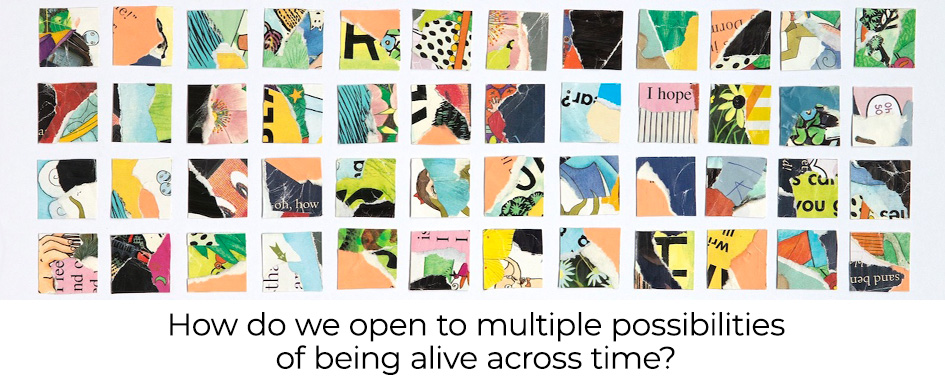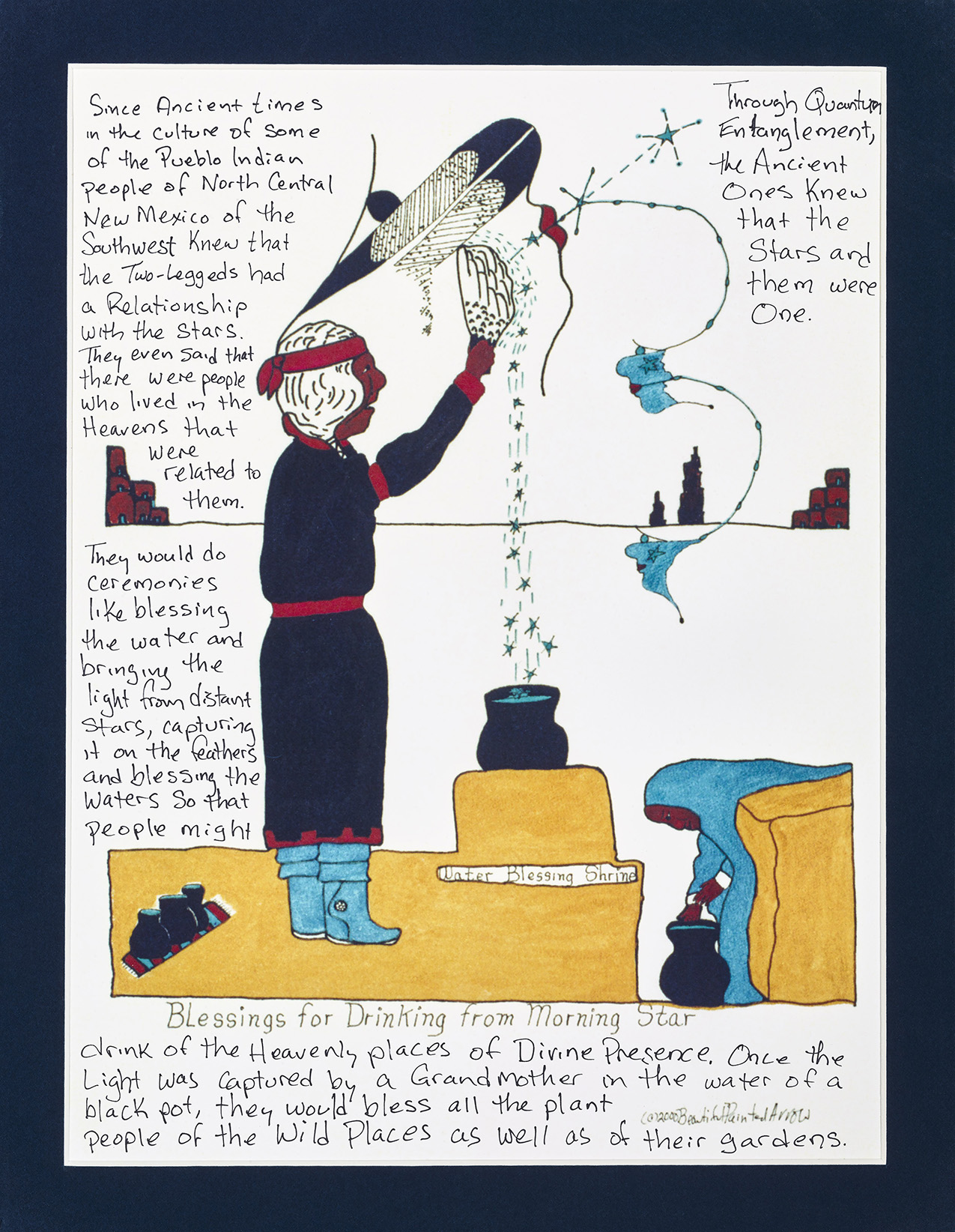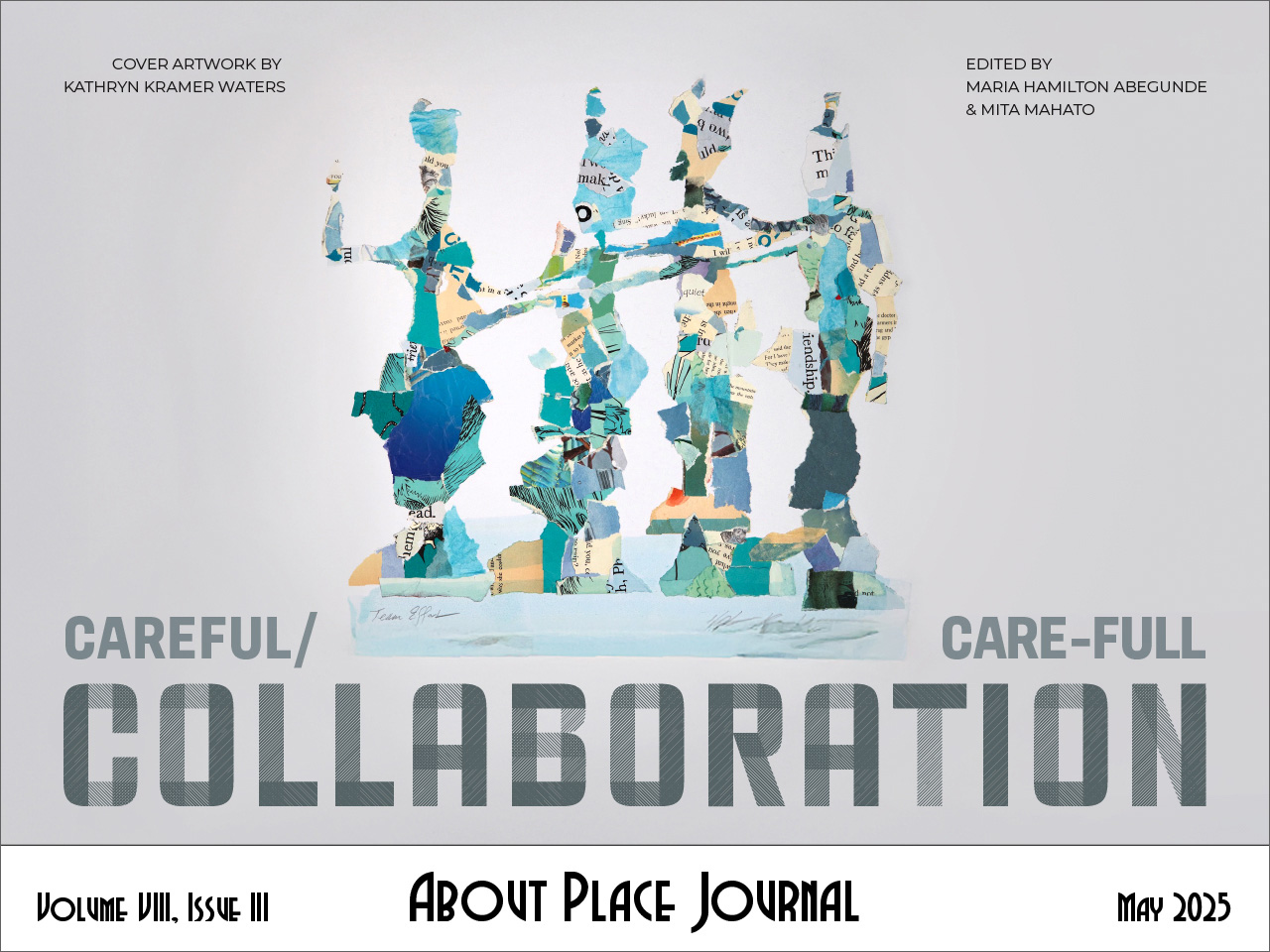I have been collaborating with Joseph Rael (Beautiful Painted Arrow) since 2014. Joseph is a Southern Ute elder and an artist, visionary, and healer, who grew up at Picuris Pueblo. I am a psychiatrist, integrative physician, artist, and author. Our collaboration has been a rich one; we have published four books and many articles, including “Making American Healthy Again: Indigenous Perspectives on Land & Health,” in About Place Journal (May 2021). We have also worked on artwork together, which will be the focus of this essay. But our collaboration has been so much more than writing and painting, it has also been a friendship and mentorship that has ushered me into a new way of seeing the world and our interconnectedness.
You could say our collaboration started in a bookstore in Chicago, in the year 2000, when I was drawn to Joseph’s book Being & Vibration. Then, in 2014 in another bookstore, I chanced upon Kurt Wilt’s book, The Visionary: Entering the Mystic Universe of Joseph Rael (Beautiful Painted Arrow). Kurt and Joseph’s collaboration charted Joseph’s visions and mystical experiences, with references to Joseph Campbell’s hero’s journey. I was moved by the book, and I emailed Kurt to thank him for his work and that I appreciated his comparison of Joseph’s life to Cambell’s hero’s journey. I mentioned that I was using the hero’s journey as a framework for a class supporting veterans to return home after military service. Kurt wrote back that Joseph would be interested in my work and gave me Joseph’s email. This led to an email exchange and Joseph invited me to visit him on the Southern Ute reservation for three days in October 2014. Thus, my collaboration with Joseph grew out of his earlier collaboration with Kurt Wilt and my chancing upon their books.
On the first day, Joseph and I met at the hotel and got into my rental car. Joseph directed me across the landscape, through space and time, as we went to the specific places on the land where he had visionary experiences over the years. At first, I wondered why we were driving to all these places instead of just sitting in a coffee shop and talking, but then I realized that Joseph was having me walk in his footsteps, going to important places on the land where he was inspired and connected to what he called non-ordinary reality.
The three-day visit turned into over ten years of collaboration: phone calls, letters, regular visits to the Southwest, four book publications, and always twice as much material for new books for every book we published. We worked steadily for a year on a book which was to use Joseph’s teachings to help veterans return home. I madly scribbled notes, took recordings (more than I could transcribe), and drew up an outline of chapters. I listed chapters I would write, chapters he would write, and chapters we would write together. It seemed very logical and organized—from an ordinary reality perspective. But after I wrote my chapters, I realized that this wasn’t how we were going to work together! Instead, Joseph told stories about his life, interspersed with wide-ranging comments about dark matter, black holes, how the Pueblo people came from the stars and would return to the stars, about his visions, about Mother Earth and how we affect her and the climate, and always about how we can work for world peace. This was an organic, holistic, and—what often seemed chaotic—collaborative style! Joseph would send me clippings with a note, “Put something about black holes in the book.” He would also tell me, “Now, this is important: we don’t exist.” He would explain this concept and I would struggle to follow. I had an intellectual framework from reading Buddhism and Hinduism, but still his statement continually caught me off guard. Often, he would also add, “la vida no mas un sueño es,” life is but a dream.
I followed Joseph’s far-ranging teachings and turned in a fascinating book to our publisher. Our publisher wrote back, “This is an interesting book, but where is the book about veterans you were going to write? What happened to Walking the Medicine Wheel: Healing Trauma and PTSD?” Ah, I realized that if I only followed where Joseph was leading, we would always end up in the circular orbits of non-ordinary reality rather than in logical, ordinary reality. I slowly began to see my role as less of a psychiatric and holistic/integrative medicine expert and more as a student, translator, and interpreter of hours of Joseph’s teachings. I would listen, enter into Joseph’s world, and let myself become a “hollow bone.” This is how Joseph described the ability of healers to heal—not through themselves, but by allowing healing energy to flow through them like a conduit. I tried to become this hollow bone for Joseph’s teachings. Then, I would sit down and translate my understanding of his non-ordinary reality teachings into a semi-linear framework that someone could understand starting from an ordinary reality perspective. Even the frequent Tiwa (the language of Picuris Pueblo) words that Joseph would use in his teachings required work to spell, as Tiwa is an oral language. Joseph would repeat words over and over and help me pronounce them, to listen and appreciate the ripples of meaning that came from the vibrations of sound. But, when I would ask how to spell them, he would often say, “Just spell them how they sound to you, you’re good at that.”
Joseph’s trust in me was empowering, but it also made me worry about the responsibility and the possibility of misunderstanding or misrepresenting what he was saying. Compared to John Niehardt’s writing about the teachings of Black Elk, our era has a better understanding of cultural appropriation. I was constantly doing a balancing act of being true to Joseph’s teachings while presenting an understandable narrative. At times, I thought of myself as an ethnographer, objectively documenting Joseph’s teachings, but the work was often more of an apprenticeship. From the very beginning, Joseph had me walk in his footsteps in the places on the Earth where he had his visionary experiences. To write about non-ordinary reality, one must experience it.
Another metaphor for our work together was of us being “doors” for each other. When I walked through Joseph’s door, I entered the world of the mystic and the shaman. I could write about concepts that were common to Joseph’s world, but that I would be reluctant to write about as a physician and aspiring academic. The “door” I provided for Joseph was to bring his ideas into mainstream and holistic medical communities.
I came to understand that the reality Joseph was teaching me was like continuously walking through one door after another into new rooms. The purpose was not to get comfortable in a room, but only to have the momentary experience of that room and then open the door to the next. This reality was not static, but constantly changing and transforming. To try to persist, and to stay in a room, was to not exist. Existence was only possible in the disorienting moment of exploration of opening a door. Non-ordinary reality, the place of healing and visions, is not fixed, but rather something that we are striving to co-create in every moment—a kind of perpetual epiphany or theophany.
Wah-Mah-Chi is the Tiwa word for God, which Joseph translates as “breath, matter, movement.” We only exist when we are uniting and harmonizing our breath with our matter and putting it into movement. One way of doing this is through work. “Work is worship,” Joseph’s grandparents taught him. So, too, is walking, or anything you are doing where you bring together breath, matter, and movement.
Another way of bringing breath, matter, and movement together is through artwork and painting. Joseph has been painting for years. His artwork comes from his visions of non-ordinary reality that he channels into his paintings. He combines the traditional Pueblo styles he learned from José Rey Toledo, Velino Herrera, and Gerald Nailor, with his own inspirations. Joseph gives his paintings away and doesn’t keep track of who he gives them to. We have no idea how many paintings he has made! I’ve put together a digital archive of over 450 paintings, but this is just a small fraction of the work he has done and circulated into the world.
After we had been working together for a few years, Joseph started asking me to finish certain things on some pieces. With the painting, “Eagle dancing feather Medicine heals,” Joseph asked me to write the word “Becoming” and “the people” into the text of the original. This eventually became the cover for our first book, Becoming Medicine: Pathways of a Living Spirituality. This was the second book we published, but it contains much of the far-ranging and free-flowing text of our first discussions.
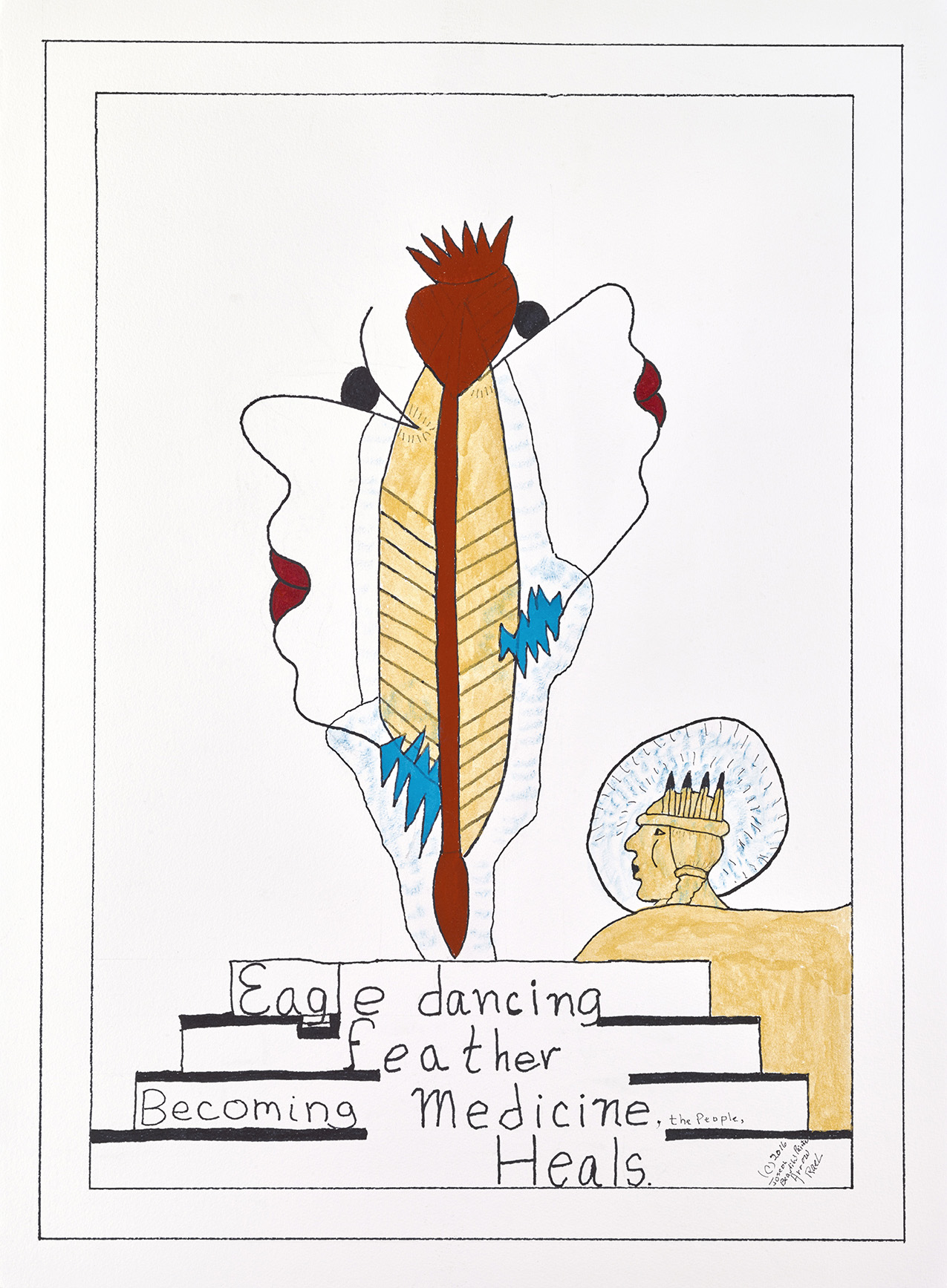
It was an exciting honor to be given these paintings to add to and complete, but it was also a lot of responsibility. Sometimes I wasn’t sure if the painting worked out the way Joseph would have done it, but I guess that is the point of collaboration. I tried to do it in “his style,” but as a painter, myself, I had my own style. For instance, with the painting, “Grand Father God creates all of the universes,” Joseph sent me the canvas with just the outlines of the shapes and words. I used a Sharpie marker over the words and shapes that Joseph had drawn. Then I added various colors of paint. I realized I used more solid colors than Joseph would. He uses a lot of negative space in his artwork, and I tend to use a lot of paint. When I look at this painting, sometimes I like it and other times I think I didn’t complete it the way Joseph would have. It is only as I’m writing this that I’m coming to be ok with how it turned out. Collaboration, after all, is bringing together two or more perspectives into something new and different than what can be done alone.
In the painting, the pottery bowl emanates from Grand Father God’s fingertip. It is filled with cornmeal. The small, human figure also holds a bowl filled with cornmeal (the way non-ordinary reality works the same bowl can appear in different realities). Joseph wrote near the human figure, “The two Leggeds create the vibrations of the empty places of the Vast self for they are the co-creators.” Vast self is another term that Joseph uses sometimes for God or Wah-Mah-Chi. We also partake in vast self, but not when we are full (of ourselves, or of beliefs and ideas), but only when we are empty. It is only in the emptiness of our non-existence that we can create the space for vast self to manifest.
In our most recent book together, A Bowl Full of Ideas for Inventive Minds, Joseph begins by talking about the principle idea of the bowl, an empty space that can hold things. We have bowls for our cereal and when the ancestors came into the land, they looked for valleys that were like bowls, with rivers and plants and animals collecting in the bowl.
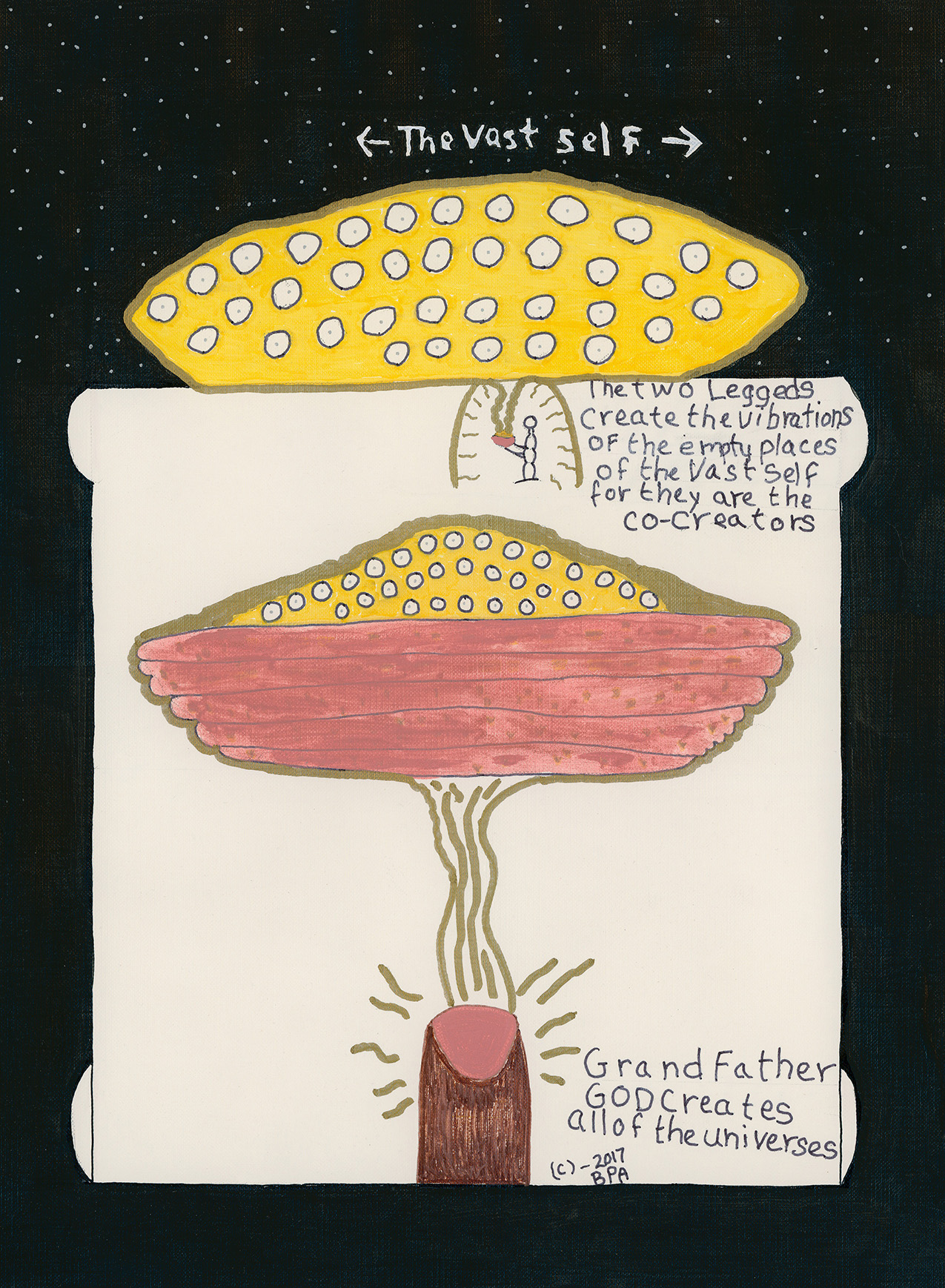
Another collaboration was with the painting “Blessings for Drinking from Morning Star.” Joseph handed me a print of the original painting and then asked me to write what he dictated to me. The text describes how the Ancient Ones knew of our Oneness with the distant stars and how they channeled their blessings into a pot with water that could be used to water both the wild plants and the garden plants. Interconnection of all beings and all life is a common theme in Joseph’s teaching.
“Blessings for Drinking from Morning Star” – acrylic and marker on paper, 12″ × 18″
Click here for accessible text
They would do ceremonies like blessing the water and bringing the light from distant stars, capturing it on the feathers and blessing the waters so that people might drink of the Heavenly places of Divine Presence. Once the Light was captured by a Grandmother in the water of a black pot, they would bless all the plan people of the Wild Places as well as of their gardens.
(Upper right of drawing) Through Quantum Entanglement, the Ancient Ones Knew that the Stars and them were one.
A final artistic collaboration I’ll mention is a pencil sketch that Joseph sent me entitled, “Seeds for a new dawn.” I drew over the pencil lines with Sharpie and then made several tracings. I painted several trial versions of the tracings. I tried to keep more empty space, but the bowl didn’t look right, and I ended up filling it with color. I used different colors of Sharpie oil paint pens for this piece.
When I spoke with Joseph in February 2025, he continued to be optimistic about our country and about life on Earth, even though there are so many reasons for worry and despair. Every time I speak with Beautiful Painted Arrow, he ushers me through new doors of reality, and he scatters seeds for a new dawn. One time, Joseph said to me, “A lot of people have been working on world peace, but we haven’t gotten there yet. You and I have been working on this too long to give up now!”
What do we do when we find ourselves in darkness? We look for the seeds that only grow in the darkness of the soil. We look for the seeds for the new dawn that will grow out of Mother Earth.
Why do we do this work? Because work is worship and because worship is what transforms us from human beings into the medicine that we need.
How do we do this? We do it through careful and care-full collaboration with each other.
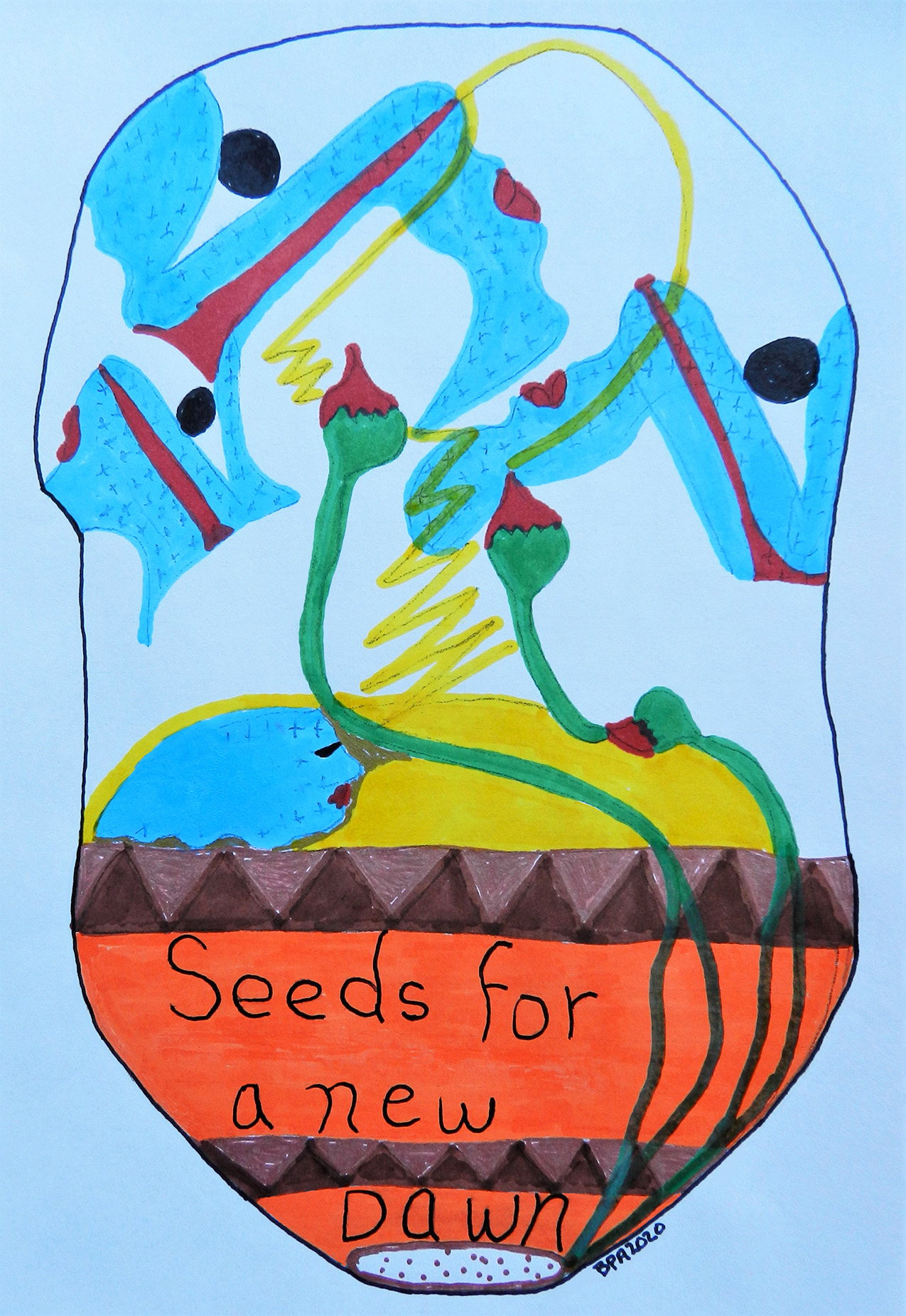
References
Kopacz, D & Rael, J. “Making American Healthy Again: Indigenous Perspectives on Land & Health,” About Place Journal (May, 2021) https://aboutplacejournal.org/issues/geographies-of-justice/ways-of-seeing/david-r-kopacz-md-and-joseph-rael-beautiful-painted-arrow/.
Kopacz, D. & Rael, J. Walking the Medicine Wheel: Healing Trauma & PTSD. Pointer Oak Books & Tri-S Foundation, distributed by Millichap Books (2016). https://www.davidkopacz.com/walking-the-medicine-wheel
Kopacz, D. & Rael, J. Becoming Medicine: Pathways of Initiation into a Living Spirituality. Condor & Eagle Press (2020). https://www.davidkopacz.com/becoming-medicine
Rael, J. & Kopacz, D. A Bowl Full of Ideas for Inventive Minds. Condor & Eagle Press (2023). https://www.davidkopacz.com/a-bowl-full-of-ideas-for-inventive-minds

